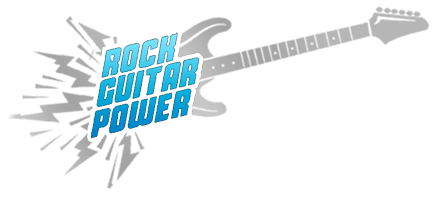Understanding How Guitar Chords and Music Scales Work Together
If you are learning to play guitar and are starting to get into playing leads, solos, and improvising, then it is very important to understand what guitar scales to practice and when to use them. Before we go shredding away playing crazy guitar solos, we need to take a look at what type of chords are being used in our song or chord progression to help us decide what scales on guitar will work the best.
The basic idea of how chords and scales go together is this:
If a chord is only made up of a couple notes (such as a power chord):

Then you will want to play a pentatonic scale over it because this scale only has five notes in it.

Our Volume 1 course has lessons to teach you both Power Chords and the Minor Pentatonic Scale.
If a chord is made up of three or more notes (such as a major or minor chord):

Full major and minor scales will work better because they are made up of seven notes and have more notes in common with the chord.

Our Volume 2 course has lessons to teach you both Major/Minor Chords and Scales.
One of the great things about soloing and using scales in rock music is that once you have found your key signature and corresponding scale, you don’t need to worry about changing it if you don’t want to. The one scale will work great for the whole song. When playing over more complex styles of music, such as jazz, one guitar scale won’t work for the entire song. You need to change scales as the chords change.
The most popular type of chord in Rock music is by far the Power Chord. If your looking for basic guitar chords then look no further. Power Chords are the simplest chords for guitar because they only contain two notes, the root and the fifth. When you’re playing guitar scales over a chord you want the two to have as many notes in common as possible. Since a power chord only has two notes in it, a pentatonic scale (the king of all rock guitar scales) is always a great choice to use. This is because it is made up of only five notes instead of seven like the major and minor scale has. The one thing that you need to make sure of is that you are starting the scale on the same root note as the key signature (i.e. if your song is in A Minor, then you need to start the minor pentatonic scale on an A).
Should I use a Major or Minor Pentatonic Scale?
The safest bet here is to always stick with the Minor Pentatonic Scale. Most rock songs and chord progressions are in minor key signatures so the minor pentatonic scale will always work great. You can always use the major pentatonic scale too, you just have to make sure to play it in the relative major key (we will talk more about this concept in future articles).
When should I use full Major and Minor scales?
I am a big fan of Major and Minor scales because they give you the opportunity to really shred and they give you the ability to create very fluid lines. Using them in rock music is a little trickier than using minor pentatonic scales though. The best time to use these scales is when your song uses major and minor chords instead of power chords. The cool thing about these types of chord progressions is that you can still use a Minor Pentatonic Scale if you want to keep it simple or you can integrate both scales and create some really cool and unique licks.
If you’re interested in checking out Rock Guitar Power, take our Guitar Skill Level Survey and get a Free 7 Day All Access Membership!
We have lessons to help you learn the scales and chords mentioned in this article. Here’s the programs to check out once you activate your membership:
Power Chords and The Minor Pentatonic Scale – Volume 1
Major & Minor Bar Chords and Major & Minor Scales – Volume 2

The most popular type of chord in Rock music is by far the Power Chord.
Like a Power Bar….chord?
Hey Marko, Thanks for the comment.. I’m not quite sure what you are asking. Can you explain a little more so that I can give you the best answer.